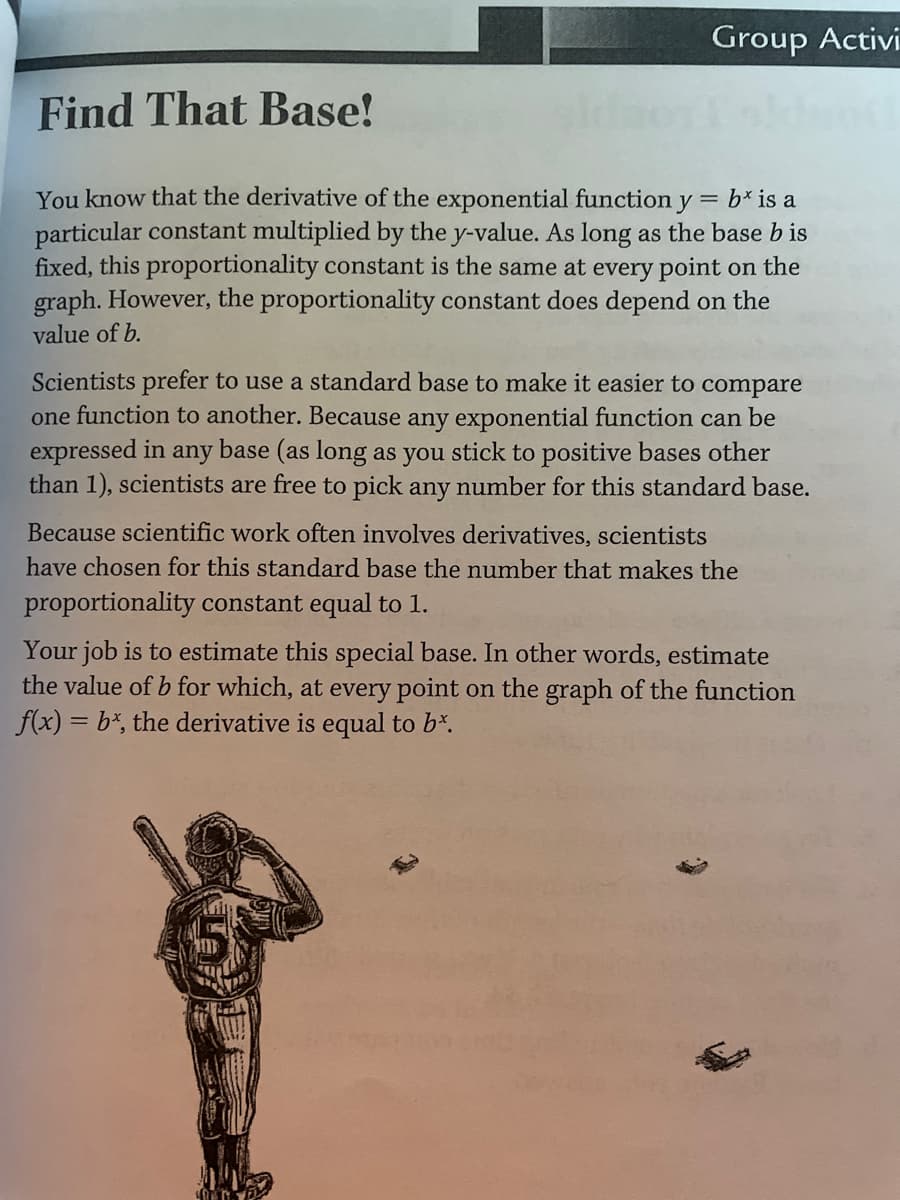Your job is to estimate this special base. In other words, estimate the value of b for which, at every point on the graph of the function f(x) = b*, the derivative is equal to b*. %3D
Your job is to estimate this special base. In other words, estimate the value of b for which, at every point on the graph of the function f(x) = b*, the derivative is equal to b*. %3D
Functions and Change: A Modeling Approach to College Algebra (MindTap Course List)
6th Edition
ISBN:9781337111348
Author:Bruce Crauder, Benny Evans, Alan Noell
Publisher:Bruce Crauder, Benny Evans, Alan Noell
Chapter5: A Survey Of Other Common Functions
Section5.4: Combining And Decomposing Functions
Problem 14E: Decay of Litter Litter such as leaves falls to the forest floor, where the action of insects and...
Related questions
Concept explainers
Rate of Change
The relation between two quantities which displays how much greater one quantity is than another is called ratio.
Slope
The change in the vertical distances is known as the rise and the change in the horizontal distances is known as the run. So, the rise divided by run is nothing but a slope value. It is calculated with simple algebraic equations as:
Question
100%

Transcribed Image Text:Group Activi
Find That Base!
You know that the derivative of the exponential function y = b* is a
particular constant multiplied by the y-value. As long as the base b is
fixed, this proportionality constant is the same at every point on the
graph. However, the proportionality constant does depend on the
value of b.
Scientists prefer to use a standard base to make it easier to compare
one function to another. Because any exponential function can be
expressed in any base (as long as you stick to positive bases other
than 1), scientists are free to pick any number for this standard base.
Because scientific work often involves derivatives, scientists
have chosen for this standard base the number that makes the
proportionality constant equal to 1.
Your job is to estimate this special base. In other words, estimate
the value of b for which, at every point on the graph of the function
f(x) = b*, the derivative is equal to b*.
Expert Solution
This question has been solved!
Explore an expertly crafted, step-by-step solution for a thorough understanding of key concepts.
This is a popular solution!
Trending now
This is a popular solution!
Step by step
Solved in 2 steps with 2 images

Knowledge Booster
Learn more about
Need a deep-dive on the concept behind this application? Look no further. Learn more about this topic, algebra and related others by exploring similar questions and additional content below.Recommended textbooks for you

Functions and Change: A Modeling Approach to Coll…
Algebra
ISBN:
9781337111348
Author:
Bruce Crauder, Benny Evans, Alan Noell
Publisher:
Cengage Learning

Algebra & Trigonometry with Analytic Geometry
Algebra
ISBN:
9781133382119
Author:
Swokowski
Publisher:
Cengage

College Algebra
Algebra
ISBN:
9781305115545
Author:
James Stewart, Lothar Redlin, Saleem Watson
Publisher:
Cengage Learning

Functions and Change: A Modeling Approach to Coll…
Algebra
ISBN:
9781337111348
Author:
Bruce Crauder, Benny Evans, Alan Noell
Publisher:
Cengage Learning

Algebra & Trigonometry with Analytic Geometry
Algebra
ISBN:
9781133382119
Author:
Swokowski
Publisher:
Cengage

College Algebra
Algebra
ISBN:
9781305115545
Author:
James Stewart, Lothar Redlin, Saleem Watson
Publisher:
Cengage Learning


Big Ideas Math A Bridge To Success Algebra 1: Stu…
Algebra
ISBN:
9781680331141
Author:
HOUGHTON MIFFLIN HARCOURT
Publisher:
Houghton Mifflin Harcourt

Algebra and Trigonometry (MindTap Course List)
Algebra
ISBN:
9781305071742
Author:
James Stewart, Lothar Redlin, Saleem Watson
Publisher:
Cengage Learning